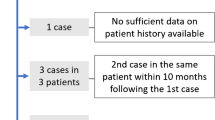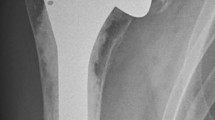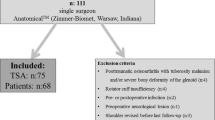Abstract
Glenoid component loosening is the weak point in the failure of total shoulder arthroplasty (TSA). In this study we analyse the radiographic risk factors observed on 86 cemented polyethylene glenoid components and their relationship with clinical signs at a mean follow-up of 5.8 years. Clinical assessment included Simple Shoulder Test (SST) and Constant-Murley score. Radiograms were taken to detect periprosthetic radiolucency, tilt, medial displacement and polyethylene thinning. Pearson’s correlation coefficient and Spearman’s rank correlation coefficient were calculated for statistical analysis. In 61 patients (71%) lucent lines were less than 2 mm wide (grade 2) and in 6 cases (7%) they were ≥2 mm wide (grade 3 and 4). Thinning of the polyethylene was found in 11 cases (13%), glenoid tilt in 6 cases (7%) and medial migration of the component in 5 cases (6%). Complete glenoid prosthetic loosening was found in 3 cases (3.5%) associated with polyethylene wear and glenoid bone loss. The Constant-Murley score associated with radiolucency grade 3 and 4 was less than 45% (38.39 ± 8.9) (p < 0.05), while a score less than 56% (30.72 ± 8.7) was found in patients with glenoid tilt and medial migration (p < 0.01). The mean SST score was 4.8 ± 2.8 in case of glenoid tilt and migration of the component (p < 0.01). Removal of the glenoid component and conversion to hemiarthroplasty or reverse prostheses is suggested in painful glenoid loosening. An exhaustive analysis of radiograms is essential to detect early and late complications or risk factors of glenoid loosening.
Similar content being viewed by others
References
Antuna SA, Cofield RH, Rowland CM (2001) Glenoid revision surgery after total shoulder arthroplasty. J Should Elbow Surg 10:217–224
Cheung EV, Sperling JW, Cofield RH (2007) Reimplantation of a glenoid component following component removal and allogenic bone-grafting. J Bone Joint Surg Am 89:1777–1783
Matsen FA III, Clinton J, Lynch J et al (2008) Glenoid component failure in total shoulder arthroplasty. J Bone Joint Surg Am 90:885–896
Bohsali KI, Wirth MA, Rockwood CA Jr (2006) Complications of total shoulder arthroplasty. J Bone Joint Surg Am 88:2279–2292
Hasan SS, Leith JM, Campbell B et al (2002) Characteristics of unsatisfactory shoulder arthroplasties. J Shoulder Elbow Surg 11:431–441
Braman JP, Falicov A, Boorman R, Matsen FA 3rd (2006) Alterations in surface geometry in retrieved polyethylene glenoid component. J Orthop Res 24:1249–1260
Hertel R, Ballmer FT (2003) Observations on retrieved glenoid components. J Arthroplasty 18:361–366
Lippitt S, Harryman D II, Matsen FA 3rd (1993) A practical tool for evaluating shoulder function: the Simple Shoulder Test. In: Matsen FA 3rd, Fu F, Hawkins RJ (eds) The shoulder: a balance of mobility and stability. American Academy of Orthopaedic Surgeons, Rosemont, IL, pp 501–518
Constant CR, Murley AH (1987) A clinical method of functional assessment of the shoulder. Clin Orthop 214:160–164
Walch G, Badet R, Boulahia A, Khoury A (1999) Morphologic study of the glenoid in primary glenohumeral osteoarthritis. J Arthroplasty 14:756–760
Mileti J, Boardman ND, Sperling JW et al (2004) Radiographic analysis of polyethylene glenoid components using modern cemented technique. J Shoulder Elbow Surg 13:492–498
Klepps S, Chiang AS, Miller S et al (2005) Incidence of early radiolucent glenoid lines in patients having total shoulder replacements. Clin Orthop Rel Res 435:118–125
Lazarus MD, Jensen KL, Southworth C, Matsen FA 3rd (2002) The radiographic evaluation of keeled and pegged glenoid component insertion. J Bone Joint Surg Am 84:1174–1182
Merolla G, Paladini P, Campi F, Porcellini G (2008) Efficacy of anatomical prostheses in shoulder anatomical arthroplasty. Chir Organ Mov 91:109–115
Edwards TB, Boulahia A, Kempf J et al (2004) Shoulder arthroplasty in patients with osteoarthritis and dysplastic glenoid morphology. J Shoulder Elbow Surg 13:1–4
Sperling JW, Cofield RH, Rowland CH (2004) Minimum fifteenyear follow-up of Neer hemiarthroplasty and total shoulder arthroplasty in patients aged fifty years or younger. J Shoulder Elbow Surg 13:604–613
Cheung EV, Sperling JW, Cofield RH (2008) Revision shoulder arthroplasty for glenoid component loosening. J Shoulder Elbow Surg 17:371–375
Chin PY, Sperling JW, Cofield RH, Schleck C (2006) Complications of total shoulder arthroplasty: are they fewer or different? J Shoulder Elbow Surg 15:19–22
Franklin JL, Barrett WP, Jackins SE, Matsen FA 3rd (1988) Glenoid loosening in total shoulder arthroplasty. Association with rotator cuff deficiency. J Arthroplasty 3:39–46
Merolla G, Di Pietto F, Romano S et al (2008) Radiographic analysis of shoulder anatomical arthroplasty. Eur J Rad 68:159–169
Mallon WJ, Brown HR, Vogler JB 3rd, Martinez S (1992) Radiographic and geometric anatomy of the scapula. Clin Orthop Rel Res 277:142–154
Barwood S, Setter KJ, Blaine TA, Bigliani LU (2008) The incidence of early radiolucencies about a pegged glenoid component using cement pressurization. J Shoulder Elbow Surg 17:703–708
Sperling JW, Cofield RH, O’Driscoll SW et al (2000) Radiographic assessment of ingrowth total shoulder arthroplasty. J Shoulder Elbow Surg 9:507–513
Porcellini G, Campi F, Paladini P (2005) Shoulder replacement in osteoarthritis. Timeo Editore, Bologna, Italy
Author information
Authors and Affiliations
Corresponding author
Rights and permissions
About this article
Cite this article
Merolla, G., Campi, F., Paladini, P. et al. Correlation between radiographic risk for glenoid component loosening and clinical scores in shoulder arthroplasty. Musculoskelet Surg 93 (Suppl 1), 29–34 (2009). https://doi.org/10.1007/s12306-009-0008-4
Published:
Issue Date:
DOI: https://doi.org/10.1007/s12306-009-0008-4




